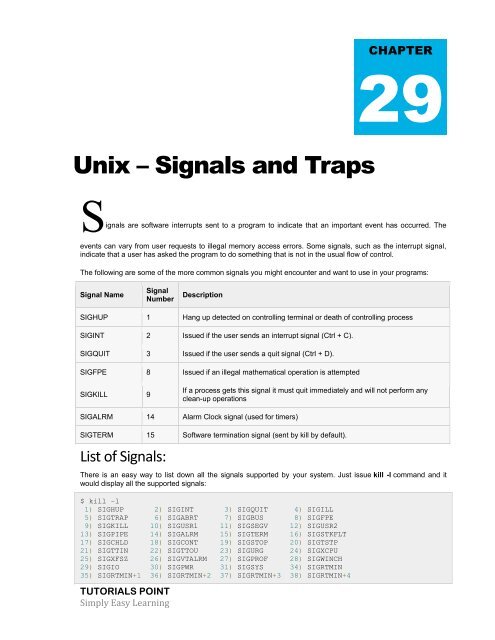Create successful ePaper yourself
Turn your PDF publications into a flip-book with our unique Google optimized e-Paper software.
<strong>Unix</strong> – Signals and Traps<br />
CHAPTER<br />
29<br />
Signals are software interrupts sent to a program to indicate that an important event has occurred. The<br />
events can vary from user requests to illegal memory access errors. Some signals, such as the interrupt signal,<br />
indicate that a user has asked the program to do something that is not in the usual flow of control.<br />
The following are some of the more common signals you might encounter and want to use in your programs:<br />
Signal Name<br />
Signal<br />
Number<br />
Description<br />
SIGHUP 1 Hang up detected on controlling terminal or death of controlling process<br />
SIGINT 2 Issued if the user sends an interrupt signal (Ctrl + C).<br />
SIGQUIT 3 Issued if the user sends a quit signal (Ctrl + D).<br />
SIGFPE 8 Issued if an illegal mathematical operation is attempted<br />
SIGKILL 9<br />
If a process gets this signal it must quit immediately and will not perform any<br />
clean-up operations<br />
SIGALRM 14 Alarm Clock signal (used for timers)<br />
SIGTERM 15 Software termination signal (sent by kill by default).<br />
List of Signals:<br />
There is an easy way to list down all the signals supported by your system. Just issue kill -l command and it<br />
would display all the supported signals:<br />
$ kill -l<br />
1) SIGHUP 2) SIGINT 3) SIGQUIT 4) SIGILL<br />
5) SIGTRAP 6) SIGABRT 7) SIGBUS 8) SIGFPE<br />
9) SIGKILL 10) SIGUSR1 11) SIGSEGV 12) SIGUSR2<br />
13) SIGPIPE 14) SIGALRM 15) SIGTERM 16) SIGSTKFLT<br />
17) SIGCHLD 18) SIGCONT 19) SIGSTOP 20) SIGTSTP<br />
21) SIGTTIN 22) SIGTTOU 23) SIGURG 24) SIGXCPU<br />
25) SIGXFSZ 26) SIGVTALRM 27) SIGPROF 28) SIGWINCH<br />
29) SIGIO 30) SIGPWR 31) SIGSYS 34) SIGRTMIN<br />
35) SIGRTMIN+1 36) SIGRTMIN+2 37) SIGRTMIN+3 38) SIGRTMIN+4<br />
TUTORIALS POINT<br />
Simply Easy Learning



